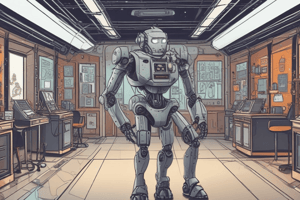Podcast
Questions and Answers
What are the three different types of RPA?
What are the three different types of RPA?
- Rule-based RPA, Cognitive RPA, Script-based RPA
- Attended RPA, Unattended RPA, Hybrid RPA (correct)
- Sequential RPA, Parallel RPA, Asynchronous RPA
- Front-office RPA, Back-office RPA, Middle-office RPA
What are the major differences between Blue Prism and UiPath?
What are the major differences between Blue Prism and UiPath?
- Blue Prism is rule-based, UiPath is cognitive
- Blue Prism uses visual designer interface, UiPath uses flowchart designer interface (correct)
- Blue Prism is cognitive, UiPath is rule-based
- Blue Prism uses flowchart designer interface, UiPath uses visual designer interface
What are the components of RPA with schematic diagram?
What are the components of RPA with schematic diagram?
- Process Layer, Task Layer, Control Layer (correct)
- Presentation Layer, Business Layer, Data Layer
- Front-end Layer, Middleware Layer, Back-end Layer
- Input Layer, Processing Layer, Output Layer
What are the key vendors, their client market, and company specifications of RPA Platform?
What are the key vendors, their client market, and company specifications of RPA Platform?
Explain the 4 Phases of Robotic Process Automation Life cycle.
Explain the 4 Phases of Robotic Process Automation Life cycle.
Match the following SDLC phases with their descriptions:
Match the following SDLC phases with their descriptions:
Match the following SDLC models with their characteristics:
Match the following SDLC models with their characteristics:
Match the following RPA benefits with their descriptions:
Match the following RPA benefits with their descriptions:
Match the following programming languages with their primary usage:
Match the following programming languages with their primary usage:
Match the following RPA platforms with their features:
Match the following RPA platforms with their features:
Flashcards are hidden until you start studying
Study Notes
Types of RPA
- Attended RPA: Runs alongside human workers, assisting them in real-time tasks.
- Unattended RPA: Operates independently to execute tasks without human intervention, usually for back-office processes.
- Hybrid RPA: Combines both attended and unattended automation, allowing for flexible task execution based on user needs.
Blue Prism vs. UiPath
- Blue Prism focuses on enterprise-level deployment, emphasizing security and scalability.
- UiPath offers a more user-friendly interface and easier integration with existing systems, appealing to a broader spectrum of businesses.
- Blue Prism requires extensive programming knowledge for customization, whereas UiPath supports low-code design, making it accessible to non-technical users.
Components of RPA
- Bots: Software agents that execute automated processes.
- Control Center: Provides monitoring, analytics, and management of bots.
- Development Studio: User interface for designing and testing automation workflows.
- Orchestrator: Manages bot scheduling, deployment, and execution.
Key Vendors of RPA Platforms
- UiPath: Targets enterprises of all sizes; known for user-friendliness and extensive community support.
- Blue Prism: Popular among large corporations with complex automation needs; emphasizes security features.
- Automation Anywhere: Focuses on cloud-based solutions, suitable for various industries.
- Pega: Known for integrating RPA with customer relationship management (CRM) systems.
4 Phases of RPA Life Cycle
- Identification: Analyzing business processes to identify opportunities for automation.
- Development: Creating and testing automation workflows using development tools.
- Deployment: Implementing automation into the operational environment.
- Monitoring: Continuously tracking performance, addressing issues, and optimizing processes.
Matching SDLC Phases with Descriptions
- Planning: Defining project scope and purpose.
- Analysis: Gathering requirements through stakeholder feedback.
- Design: Outlining system architecture and interface design.
- Implementation: Coding, system integration, and testing.
- Maintenance: Ongoing updates and bug fixes post-deployment.
Matching SDLC Models with Characteristics
- Waterfall: Linear and sequential approach, suitable for projects with clear requirements.
- Agile: Iterative approach, allowing for flexibility and collaboration in development.
- Spiral: Combines iterative development with risk assessment, ideal for large-scale projects.
- V-Model: Emphasizes verification and validation at each development phase.
Matching RPA Benefits with Descriptions
- Increased Efficiency: Automates repetitive tasks, allowing human workers to focus on complex work.
- Cost Reduction: Lower operational costs through reduced manual labor and improved process speed.
- Improved Accuracy: Minimizes human error by standardizing processes with software bots.
- Scalability: Easily adaptable to increased workload without significant additional resources.
Matching Programming Languages with Primary Usage
- Python: Widely used for data analysis and machine learning applications.
- Java: Popular for enterprise-level applications and cross-platform development.
- JavaScript: Essential for web development and enhancing interactivity on websites.
- C#: Commonly used for Windows applications and game development with Unity.
Matching RPA Platforms with Features
- UiPath: Comprehensive suite with a user-friendly interface and extensive integration capabilities.
- Blue Prism: Strong governance, enterprise-grade security features, and robust scalability.
- Automation Anywhere: Cloud-native architecture and built-in analytics for performance monitoring.
- Pega: Seamless integration with business process management (BPM) for enhanced operational continuity.
Studying That Suits You
Use AI to generate personalized quizzes and flashcards to suit your learning preferences.




